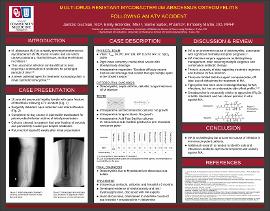| dc.description.abstract | INTRODUCTION: Mycobacterium abscessus (MA) is a rapidly-growing nontuberculous mycobacterium (NTM) found in water and soil that causes pulmonary, skin/soft tissue, and bone infections. Treatment of MA infections is difficult as there is extensive antimicrobial resistance and no consensus among experts on one standard regimen. Agents such as amikacin, cefoxitin, clofazimine, and omadacycline have been used in the treatment of this infection.
CASE DESCRIPTION: A previously healthy 15-year-old female presented for evaluation of an open midshaft fracture with visible contamination of the tibia and fibula after an ATV accident. She underwent surgical debridement and open fracture repair. Over the following two months, she had multiple readmissions for repeat debridement, and was placed on IV antibiotics for treatment of osteomyelitis due to numerous organisms. While these organisms were not recovered on subsequent intraoperative cultures, she did not have tissue healing as expected for her injury, prompting empiric expansion of therapy until acid-fast bacillus culture returned positive for M. abscessus sub. bolletii. Therapy was thus expanded to include clarithromycin and meropenem. Based on susceptibilities, the therapy was changed to amikacin, cefoxitin, and linezolid. Repeat debridements were undertaken, resulting in clearance of cultures five weeks after MA was isolated. All interim hardware was removed but an intermedullary rod was required given non-union of the tibia. Antibiotics were continued with excellent wound healing. Despite initial tolerance, after six months the patient experienced increasing serum creatinine and decreasing white blood cell count, concerning for potential amikacin and linezolid toxicities, respectively. In consultation with MA experts, the decision was made to transition to oral therapy with clofazamine, linezolid, and omadacycline. To date, laboratories are not suggestive of infection recurrence.
DISCUSSION: MA is a rapidly-growing NTM uncommonly encountered in healthy children; however, MA resistance to multiple agents is common. Current data does not support a single standard therapeutic regimen. Rather, the infection usually requires a prolonged courses of antimicrobials particularly in presence of hardware. This patient tolerated her initial regimen for the majority of her course, but she began to demonstrate evidence of possible nephrotoxicity and myelosuppression. Due to these abnormalities and the absence of data suggesting a clear total duration of therapy, transition to an oral regimen of clofazamine, omadacycline, and linezolid was planned. While the literature supporting clofazimine use for this indication is scant, for omadacycline it is limited to a NTM pulmonary case. This case highlights the need for study and identification of safe and efficacious NTM susceptible antibiotics. | en_US |

